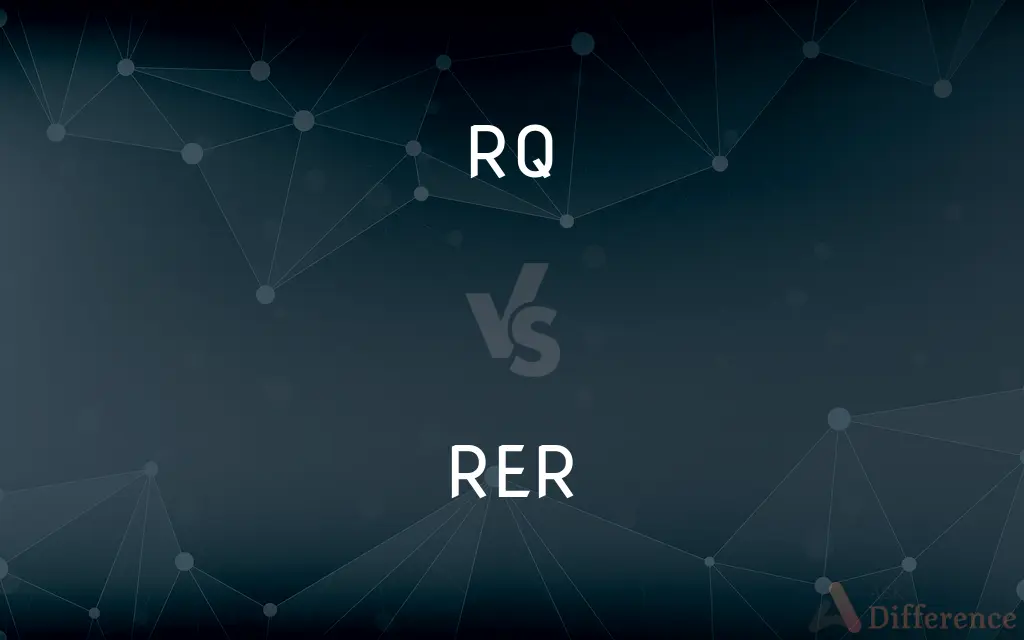RQ vs. RER — What's the Difference?
By Tayyaba Rehman & Urooj Arif — Published on February 17, 2024
RQ (Respiratory Quotient) is the ratio of CO2 produced to O2 consumed in metabolism, reflecting the type of fuel being used. RER (Respiratory Exchange Ratio) is measured during respiration, indicating the gas exchange ratio at the mouth.

Difference Between RQ and RER
Table of Contents
ADVERTISEMENT
Key Differences
RQ, or Respiratory Quotient, is a measure used in physiology and biochemistry to assess the metabolic fuel mix being utilized by an organism. It is calculated as the ratio of carbon dioxide produced (CO2) to oxygen consumed (O2) during metabolism. The RQ value can indicate which macronutrients are being metabolized, as different substrates (carbohydrates, fats, proteins) have distinct RQ values. Carbohydrates have an RQ close to 1, fats are around 0.7, and proteins are near 0.8, reflecting their oxygen to carbon dioxide output during metabolism.
RER, or Respiratory Exchange Ratio, is a similar concept but is specifically measured during physical activities or at rest, taking into account the gas exchange occurring at the level of the lungs. RER values are obtained by measuring the amount of CO2 exhaled and O2 inhaled. While RQ is purely a metabolic measure, RER includes both metabolic and respiratory influences. For instance, hyperventilation can increase the RER above the RQ by expelling more CO2 relative to O2 consumption.
The distinction between RQ and RER is significant in understanding metabolic processes and respiratory physiology. RQ is ideal for studying biochemical pathways and energy utilization in a controlled setting, reflecting the body's substrate utilization. RER, being influenced by both metabolism and respiratory factors, is valuable in exercise physiology and clinical diagnostics to assess overall physiological responses to different intensities of physical activity and to estimate metabolic rates.
While RQ values are constrained by the biochemical properties of the fuel sources being oxidized, RER values can exceed this range due to the physiological and environmental factors affecting respiratory gas exchange. This makes RER a dynamic measure that can provide insights into both metabolic efficiency and respiratory function during various states of activity and rest.
In summary, RQ and RER both describe aspects of metabolic and respiratory efficiency but from slightly different perspectives. Understanding both measures is crucial for a comprehensive assessment of an individual’s metabolic state and respiratory health, especially in clinical and sports science settings.
ADVERTISEMENT
Comparison Chart
Definition
Ratio of CO2 produced to O2 consumed in metabolism.
Ratio of CO2 expelled to O2 consumed during respiration.
Indicative of
Type of fuel (carbs, fats, proteins) being metabolized.
Metabolic and respiratory influences on gas exchange.
Measurement Setting
Biochemical metabolism.
Physiological respiration at the mouth.
Typical Values
Carbs: ~1.0, Fats: ~0.7, Proteins: ~0.8
Can vary from 0.7 to above 1.0, exceeding metabolic RQ values.
Application
Assessing metabolic fuel use in a controlled environment.
Assessing physiological state during exercise or rest.
Compare with Definitions
RQ
A precise measure for studying cellular respiration.
Cellular respiration studies often rely on RQ to gauge metabolic efficiency.
RER
RER measures gas exchange during respiration.
During the treadmill test, his RER indicated a high rate of carbohydrate metabolism.
RQ
Calculated from metabolic processes.
The RQ value helped us understand the shift in metabolism under different nutritional states.
RER
Can exceed metabolic RQ values due to respiratory effects.
Her RER exceeded 1.0 during the sprint, suggesting maximal effort.
RQ
RQ indicates the metabolic fuel source being used.
An RQ of 1.0 suggests carbohydrates are the primary fuel source.
RER
Influenced by both metabolic and respiratory factors.
The athlete's elevated RER was attributed to intense physical exertion.
RQ
Reflects the balance of oxygen and carbon dioxide in metabolism.
By analyzing RQ, researchers can deduce which substrates are being oxidized.
RER
Used in exercise physiology to assess energy expenditure.
RER values provided insights into the energy systems engaged during the marathon.
RQ
Varies with the type of nutrient metabolized.
The RQ varies significantly between fats, proteins, and carbohydrates.
RER
Reflects the body's physiological state during activity.
His RER readings during the study revealed shifts from fat to carbohydrate metabolism.
Common Curiosities
What does RQ stand for?
Respiratory Quotient, indicating the ratio of CO2 produced to O2 consumed in metabolism.
What does RER represent?
Respiratory Exchange Ratio, the ratio of CO2 expelled to O2 consumed during respiration.
Why is RER important in exercise testing?
RER helps assess the intensity of exercise and the predominant energy source being used.
Is a higher RER always indicative of better performance?
Not necessarily; a higher RER indicates carbohydrate metabolism, which depends on the exercise's duration and intensity.
What does an RQ of 1 indicate?
An RQ of 1 indicates predominant carbohydrate metabolism.
Can RER exceed RQ values?
Yes, RER can exceed RQ values, especially during intense exercise due to respiratory factors.
How are RQ and RER measured?
RQ is measured in a controlled metabolic setting, while RER is measured via gas analysis during respiration.
Can RQ and RER provide information on diet?
Yes, by indicating the primary fuel source, they can infer aspects of an individual's diet.
Can RQ change with diet?
Yes, RQ can change based on the balance of carbohydrates, fats, and proteins in the diet.
Why might RER exceed 1?
RER may exceed 1 during intense exercise due to an increase in CO2 production from bicarbonate buffering.
Why is RQ important in metabolic studies?
RQ provides insight into which metabolic pathways are active under different conditions.
What role does RQ play in clinical nutrition?
RQ can guide nutritional support by identifying the primary fuel source used by the body, important in managing metabolic diseases.
How does breathing affect RER?
Hyperventilation or changes in breathing patterns can alter CO2 levels, affecting RER measurements.
How can RER be used in weight management?
Analyzing RER can help tailor exercise programs to optimize fat loss by targeting the right energy systems.
What influences RER during rest?
RER at rest reflects the basal metabolic rate and the mix of fuels being metabolized, typically showing a balance of fats and carbohydrates.
Share Your Discovery

Previous Comparison
HPLC vs. LCMS
Next Comparison
Naruto vs. Naruto ShippudenAuthor Spotlight
Written by
Tayyaba RehmanTayyaba Rehman is a distinguished writer, currently serving as a primary contributor to askdifference.com. As a researcher in semantics and etymology, Tayyaba's passion for the complexity of languages and their distinctions has found a perfect home on the platform. Tayyaba delves into the intricacies of language, distinguishing between commonly confused words and phrases, thereby providing clarity for readers worldwide.
Co-written by
Urooj ArifUrooj is a skilled content writer at Ask Difference, known for her exceptional ability to simplify complex topics into engaging and informative content. With a passion for research and a flair for clear, concise writing, she consistently delivers articles that resonate with our diverse audience.
















































